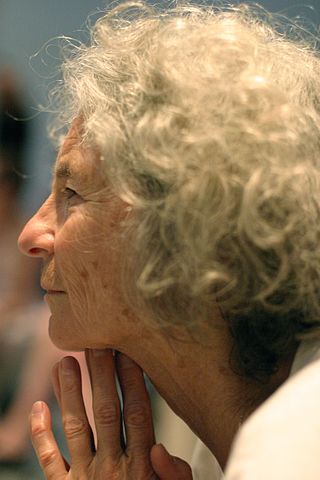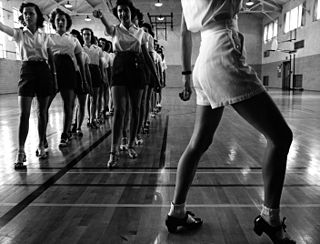Related Research Articles

Ballet is a type of performance dance that originated during the Italian Renaissance in the fifteenth century and later developed into a concert dance form in France and Russia. It has since become a widespread and highly technical form of dance with its own vocabulary. Ballet has been influential globally and has defined the foundational techniques which are used in many other dance genres and cultures. Various schools around the world have incorporated their own cultures. As a result, ballet has evolved in distinct ways.

Chelsea Victoria Clinton is an American writer and global health advocate. She is the only child of Bill Clinton, a former U.S. President, and Hillary Clinton, a former U.S. Secretary of State and 2016 presidential candidate. She was a special correspondent for NBC News from 2011 to 2014 and now works with the Clinton Foundation and Clinton Global Initiative, including taking a prominent role at the foundation with a seat on its board.

Jarabe tapatío, often referred to as the Mexican hat dance, is the national dance of Mexico. It originated as a courtship dance in Guadalajara, Jalisco, during the 19th century, although its elements can be traced back to the Spanish zambra and jarabe gitano, which were popular during the times of the viceroyalty. Female dancers traditionally wear a china poblana outfit, while the male dancers dress as charros.
"Goodnight, Irene" or "Irene, Goodnight," is a 20th-century American folk standard, written in 3
4 time, first recorded by American blues musician Huddie 'Lead Belly' Ledbetter in 1933. A version recorded by the Weavers was a #1 hit in 1950.

Dance in India comprises numerous styles of dances, generally classified as classical or folk. As with other aspects of Indian culture, different forms of dances originated in different parts of India, developed according to the local traditions and also imbibed elements from other parts of the country.
Sousta is a Greek folk dance, performed at weddings as an activity of courtship between husband and wife. It originates from Ancient Greece, and holds prominence in Dodecanese Islands, and broader Aegean region. It is the second most common Greek dance, after the Syrtos, with many Greek islands and villages adopting their own version. The performance of the dance reflects various gender roles, inter-played with values of romance and marriage. The Sousta acted as a socialisation process between the youth of a village, evolving into a dance central to these youth as they grew up and formed relationships with others. Socially, the Sousta also functioned as a visible verification of courtship, namely paying respects to the wife and her family. The Sousta is most commonly performed as a three-step dance, with a 'hopping' motion and crossed-over hands.

Ruth Page was an American ballerina and choreographer, who created innovative works on American themes.
Selma Jeanne Cohen was a historian, teacher, author, and editor who devoted her career to advocating dance as an art worthy of the same scholarly respect traditionally awarded to painting, music, and literature. She was the founding editor of the six-volume International Encyclopedia of Dance, completed in 1998.
Sonia Arova, was a Bulgarian ballerina.
Anthony Shay is a dancer and choreographer specializing in dances from Eastern Europe, the Middle East, North Africa, and Central Asia. In 50 years of work he has created over 200 choreographies.
Helena Wulff is professor of social anthropology at Stockholm University. Her research is in the anthropology of communication and aesthetics based on a wide range of studies of the social worlds of literary production, dance, and the visual arts.

Simone Forti, is an American Postmodern artist, dancer, choreographer, and writer. Since the 1950s, Forti has exhibited, performed, and taught workshops all over the world. Her innovations in Postmodern dance, including her seminal 1961 body of work, Dance Constructions, along with her contribution to the early Fluxus movement, have influenced many notable dancers and artists. Forti first apprenticed with Anna Halprin in the 1950s and has since worked alongside artists and composers Nam June Paik, Steve Paxton, La Monte Young, Trisha Brown, Charlemagne Palestine, Peter Van Riper, Dan Graham, Yoshi Wada, Robert Morris and others. Forti's published books include Handbook in Motion, Angel, and Oh Tongue. She is currently represented by The Box L.A. in Los Angeles, CA, and has works in the permanent collections of the Museum of Modern Art (MOMA) in New York, the Stedelijk Museum in Amsterdam, the Generali Foundation in Vienna, the Whitney Museum of American Art in New York, and the Moderna Museet in Stockholm.

Dance education is a practice whereby students are taught a broad understanding of dance as an art form or trained professionally in specific dance genres. Dance education also encompasses a research area in which scholars conduct original research on ways of teaching and learning dance. Currently, dance itself is considered an allied form of art and music, thus dance in formal education is closely knit with these disciplines.

Francine Dee Blau is an American economist and professor of economics as well as Industrial and Labor Relations at Cornell University. In 2010, Blau was the first woman to receive the IZA Prize in Labor Economics for her "seminal contributions to the economic analysis of labor market inequality." She was awarded the 2017 Jacob Mincer Award by the Society of Labor Economists in recognition of lifetime of contributions to the field of labor economics.

Belly dance is a Middle Eastern dance that traces its roots back to Ancient Egypt. It features movements of the hips and torso. It has evolved to take many different forms depending on the country and region, both in costume and dance style; with the Egyptian styles and costumes being the most recognized worldwide due to Egyptian cinema. The Egyptian style with its traditional Egyptian rhymes is popular worldwide with many schools around the globe now practicing it.
Nadine George-Graves is an academic who works at the intersection of African American studies, gender studies, and dance and theater history. She holds the Naomi Willie Pollard Endowed Chair at Northwestern University with appointments in the Department of Performance Studies and Deaprtment of Theatre. She is also the executive co-editor of Dance Research Journal. She has a PhD in Theater and Drama from Northwestern University, and a BA in Philosophy and Theater Studies from Yale University.

Ying Chang Compestine is a Chinese American author, speaker, television host and chef. She has written over twenty-five books including Revolution Is Not a Dinner Party (novel), based on her life growing up during the Chinese Cultural Revolution., and a middle grade novel, Morning Sun in Wuhan, set in Wuhan, China.

Gary Edward McPherson is an Australian music educator, academic and musician, who has researched various topics within the areas of musical development, music performance science and music psychology. He has served as the Ormond Chair of Music at the Melbourne Conservatorium of Music (MCM) since 2009 and between July 2009 and July 2019, served as director of the MCM at the University of Melbourne. McPherson's research primarily focuses on exploring the factors that influence the development of musical proficiency during childhood, later performance excellence, and the motivators of music participation in individuals of all ages and musical skill levels. Much of his research has been informed by his interest in the formation of musical abilities and identity in developing musicians. McPherson served as the foundation Professor of Creative Arts at the Hong Kong Institute of Education from 2002 to 2005. Prior to taking up his position at the MCM, he was a Professor of Music Education and the Marilyn Pflederer Zimmerman Endowed Chair in Music Education at the School of Music, University of Illinois at Urbana-Champaign from 2005 to 2009.

Genevieve Mary Oswald was an American dance scholar and archivist, founder and curator of the New York Public Library's dance archive.

Anca Giurchescu née Ciortea was a Romanian researcher of folk dance, and an ethnochoreologist, one of the founders of the discipline. Born in Bucharest to a family formerly from Translylvania, she lived in that region as a child. Entering university, she studied dance at the National Institute of Physical Education. During her schooling, she participated in competitive target shooting and was a silver (team) and bronze (individual) medalist in the 1955 European Shooting Championship. While still studying, she began working as a researcher at the Folklore Institute and in 1962 became a member of the International Council for Traditional Music. The Council established a working group which included Giurchescu, that laid the foundation for the science of ethnochoreology.
References
- ↑ "University of York Biography".
- ↑ Meglin, Joellen A. (2018). "Joellen A. Meglin (2018) Transitions, 2018". Dance Chronicle. 41: 1–4. doi: 10.1080/01472526.2018.1434369 .